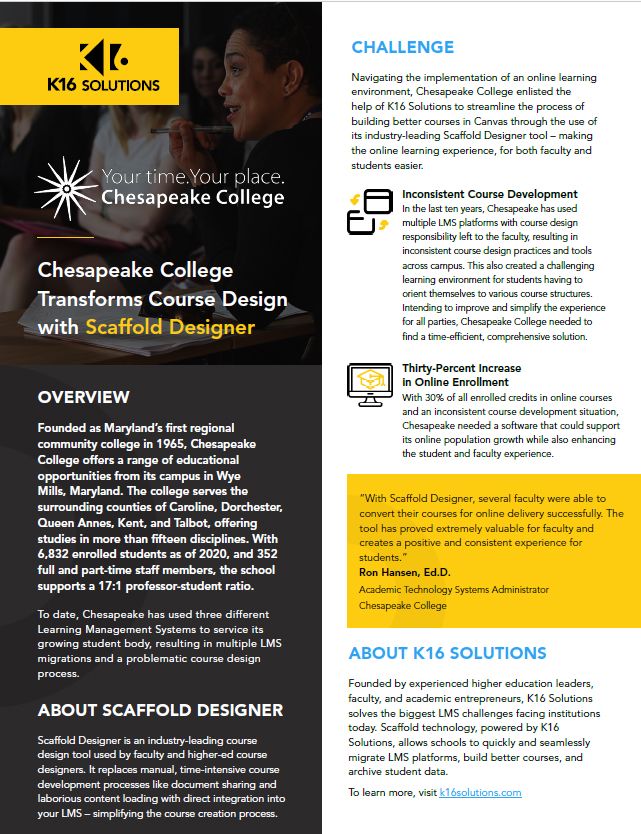New Tools Help Build Engaging Online Courses
No need for coding expertise; pre-built templates ensure consistency, speed development

Universities across the country have returned to a version of “normal” on-campus instruction. And yet many are finding that students continue to expect at least some hybrid course offerings. Whether they need the flexibility to work part time or are still fearful of being in the classroom, it’s clear that students are continuing to learn online, and universities will have to continue to evolve to meet their needs.
Faculty who thought the pandemic would bring just a temporary period of online instruction are coming to realize that they’ll need to become more comfortable with teaching both in person and online for the foreseeable future.
"Scaffold Designer helps faculty create engaging content and robust courses easily..."
In fact, recent data from the Education Department's National Center for Education Statistics and the National Council for State Authorization Reciprocity Agreements (NC-SARA) show that roughly two-thirds of the students enrolled in fall 2020 attended courses either wholly (44.7%) or partially (28%) online. What’s more, according to a voluntary survey of SARA-participating institutions, 59% plan to continue some or all of their emergency remote learning offerings via distance education after the pandemic.
Top Features of a Best-in-Class Course Design Tool
An Evaluation Guide for Course Developers
Download this evaluation mini-guide to learn more about the top features that should be included in every course design tool.
"An institution has to concentrate on building a well-structured, well-aligned course that keeps students engaged and demonstrates to accrediting bodies that the courses accomplish what they say they are accomplishing."
- Rachel Waite, Au.D.

Changing expectations
While students and accreditors may have been willing to overlook a simplistic approach to online course delivery during the pandemic’s peak, faculty who depend mostly on videotaped lectures and Dropbox for assignments will likely face a changing landscape of higher expectations.
“An institution has to concentrate on building a well-structured, well-aligned course that keeps students engaged and demonstrates to accrediting bodies that the courses accomplish what they say they are accomplishing,” says Rachel Waite, Au.D. Dr. Waite, who previously taught both in face-to-face classrooms and online before moving to curriculum management, consulted in the development of Scaffold Designer for K16 Solutions, an Arizona-based educational technology firm that provides learning management system services to a variety of educational institutions.
Scaffold Designer
Universities that had robust online offerings prior to the pandemic often paired instructional designers with subject matter experts and faculty members to build engaging courses. While effective, that system could be bureaucratic and time-consuming, making even simple updates a challenge.
But as the weight of the pandemic began to hit universities, most were unable to delegate their entire course catalogue to instructional designers. Instructional Design and Course Development teams were already stretched thin. The burden of moving traditional classroom content online has--for many--fallen largely on faculty, some of whom may have never taught an online course.
“While they know their subject matter, they are not likely to be experts in building an online course,” Waite says. That type of dynamic can leave faculty feeling adrift and place an even heavier load on already stretched instructional designers. What’s more, if faculty members are developing their courses on their own without institutional support, the experience for students could vary dramatically across the university and even within individual departments, Waite says.
Scaffold Designer aims to bridge the gap between instructors and course designers by providing a simple, customizable solution that faculty can use with limited support. “It helps create an environment in which there is a seamless transition between the online and classroom experience,” Waite says. “It’s absolutely possible to have a Socratic environment online,” Waite says. “You just need the tools to make it work.”
"Scaffold Designer is a robust tool for creating course objectives and takes it to the next level by mapping and aligning those objectives to course content."
- David Williams, Assistant Director of Course Development at the University of South Alabama

Fully-integrated course development tool
Universities working with Scaffold Designer are able to customize online offerings for their institutions and academic departments, providing a consistent student experience. “It’s configured to look like the institution with customized banners and pages,” Waite says.
With a step-by-step course development guide, faculty can build and create course modules in sequential, methodical order. Designer also provides faculty with an objectives and outcomes builder, allowing them to map course content to specific educational outcomes and ensuring that all content is aligned with course objectives.
“Scaffold Designer is a robust tool for creating course objectives and takes it to the next level by mapping and aligning those objectives to course content,” says David Williams, Assistant Director of Course Development at the University of South Alabama. It maps content to objectives, demonstrating how the material in courses aligns with the curriculum, he adds. “On top of all that, it is an easy tool to use, whether you're an Instructional Designer or a faculty member new to online education.”
Scaffold Designer’s centralized course design means academic departments can set expectations and guidelines that translate into pre-built modules. This kind of consistency translates not only across course modules but also assignments and resources.
The program’s user-friendly interface means faculty members can create course content, including images and videos. Without the need to learn HTML, instructors can focus on developing content, not writing code. “Faculty can do it themselves,” Waite says, “That allows instructional designers to come in on the back end to ensure functionality.”
While Scaffold Designer operates outside of the learning management system, it is fully integrated with an expanded list of products, including Canvas and Blackboard Ultra.
“Scaffold Designer helps faculty create engaging content and robust courses easily, while saving time and ensuring consistency across the institution,” Waite says. “It makes faculty life easier and the student experience better.”
Curriculum developers agree. Synergis Education, which partners with institutions to develop nursing programs, says Scaffold Designer is its tool of course.
“From creating course learning objectives to mapping and aligning those objectives to course content and assessments, our instructional designers co-develop courses with our partner university faculty using Scaffold Designer,” says David C. Fattu, Synergis’ Vice President of Academic Service. “Once the course curriculum is completed and has been reviewed and commented on directly in Scaffold Designer, the instructional designer or faculty will click ‘Sync to LMS’ and the course is immediately available in the university’s LMS."
This content was paid for and created by K16 Solutions. The editorial staff of The Chronicle had no role in its preparation. Find out more about paid content.







